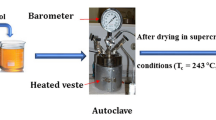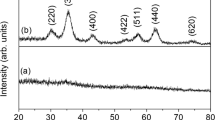Abstract
Maghemite (γ-Fe2O3) is a very common mineral at the earth’s surface and also an important material for making music and video tapes. Maghemite is usually synthesized from magnetite under oxidizing conditions after a few hours or a few days below a temperature of 300°C. The magnetic property of thermal instability and the chemical action after heating is an important character for maghemite. That is, it will become hematite in certain proportion after being heated above 250°C. Maghemite is therefore actually unable to have its Curie temperature measured. But late using synthetic sample, maghemite was further found partially thermal stable with a measurable Curie temperature ∼645°C. During our thermally magnetic experiments for a set of synthetic magnetite, we found that extra fined grain size (pseudo single domain (PSD) and small multi-domain (MD), mainly 1–10 μm) magnetite was formed to a completely thermally stable maghemite. This maghemite can also be produced by heating the same powder up to 700°C in an oven and keeping this temperature for 10 min, then cooling it down. When the generated maghemite by these two ways is heated from room temperature to 700°C, it shows almost fully reversible, or thermally stable. We used X-ray powder diffraction and Mössbauer spectroscopy to confirm the identity of this maghemite and compared its magnetic hysteresis, high temperature magnetization, low temperature thermal demagnetization, and low temperature susceptibility with those of the original preheated magnetite. Such quickly oxidized maghemite by heating to high temperature implies some types of maghemite formed in certain natural condition can carry a thermal remnant magnetization (TRM). Four types of maghemite were characterized and discussed according to their thermal stability. Among them, partially stable and fully thermally stable maghemite after heating should possess capability of carrying TRM. There is possibly a compensation of synthetizing maghemite between heating temperature and heating duration. The thermal stability of maghemite may be affected by a few factors, such as its purity (stoichiometry), heating temperature and duration. The grain size may be one of important factors. Maghemite might be similar to magnetite, having various magnetic properties corresponding to its grain size categories such as superparamagnetic (SP), single domain (SD) and MD. Low temperature measurement for PSD fine grain of synthetic magnetite shows a phenomenon of Verwey transition “suppressed”, its fundamental causes could be that the core diameter of oxidized magnetite is actually reach or approach SD size, so that its Verwey transition is shown “suppressed”.
Similar content being viewed by others
References
LeBorgne E. Anomalous magnetic susceptibility of topsoil (in French). Annals Geophys, 1955, 11: 399–419
LeBorgne E. Influence of fire on the magnetic properties of the soil and those of schist and granite (in French). Annals Geophys, 1960, 16: 159–195
Mullins C E. Magnetic susceptibility of the soil and its significance in soil science—A review. J Soil Sci, 1977, 28: 223–246
Maher B A, Taylor R M. Formation of ultrafine-grained magnetite in soils. Nature, 1988, 336: 368–370
Maher B A. Magnetic properties of modern soils and Quaternary loessic paleosols: Paleoclimatic implications. Paleogeogr Paleoclimatol Paleoecol, 1998, 137: 25–54
Guyodo Y, LaPara T M, Anschutz A J, et al. Rock magnetic, chemical and bacterial community analysis of a modern soil from Nebraska. Earth Planet Sci Lett, 2006, 251: 168–178
Banerjee S K. Environmental magnetism of nanophase iron minerals: Testing the biomineralization pathway. Phys Earth Planet Inter, 2006, 154: 210–221
Kletetschka G, Banerjee S K. Magnetic stratigraphy of Chinese loess as a record of natural fires. Geophys Res Lett, 1995, 22: 1341–1343
Torrent J, Barrón V, Liu Q S. Magnetic enhancement is linked to and precedes hematite formation in aerobic soil. Geophys Res Lett, 2006, 33: L02401, doi: 10.1029/2005GL024818
Taylor R M, Schwertmann U. Maghemite in soils and its origin, I. Properties and observations on soil maghemites. Clay Min, 1974, 10: 289–298
Heller F, Liu T S. Magnetism of Chinese loess deposits. Geophys J R Astr Soc, 1984, 77: 125–141
Maher B A, Thompson R. Quaternary Climates, Environments and Magnetism. Cambridge: Cambridge University Press, 1999. 390
Liu X M, Hesse P, Rolph T. Origin of maghaemite in Chinese loess deposits: Aeolian or pedogenic? Phys Earth Planet Inter, 1999, 112: 191–201
Liu Q S, Deng C L, Yu Y, et al. Temperature dependence of magnetic susceptibility in an argon environment: Implications for pedogenesis of Chinese loess/palaeosols. Geophys J Int, 2005, 161: 102–112
Liu X M, Hesse P, Rolph T, et al. Properties of magnetic mineralogy of Alaskan loess: Evidence for pedogenesis. Quat Int, 1999, 62: 93–102
Matasova G, Petrovsky E, Jordanova N, et al. Magnetic study of Late Pleistocene loess/palaeosol sections from Siberia: Palaeoenvironmental implications. Geophys J Int, 2001, 147: 367–380
Zhu R X, Matasova G, Kazansky A, et al. Rock magnetic record of the last glacial-interglacial cycle from the Kurtak loess section, southern Siberia. Geophys J Int, 2003, 152: 335–343
Liu X M, Liu T S, Hesse P, et al. Two pedogenic models for paleoclimatic records of magnetic susceptibility from Chinese and Siberian loess. Sci China Ser D-Earth Sci, 2008, 51: 284–293
Liu X M, Liu T S, Heller F, et al. Frequency-dependent susceptibility of loess and Quaternary paleoclimate (in Chinese). Quat Sci, 1990, 1: 42–50
Liu Q S, Deng C L. Magnetic susceptibility and its environmental significances (in Chinese). Chin J Geophys, 2009, 52: 1041–1048
Barrón V, Torrent J. Evidence for a simple pathway to maghemite in Earth and Mars soils. Geochim Cosmochim Acta, 2002, 66: 2801–2806
Torrent J, Liu Q S, Bloemendal J, et al. Magnetic enhancement and iron oxides in the upper Luochuan loess-paleosol sequence, Chinese Loess Plateau. Soil Sci Soc Am J, 2007, 71: 1570–1578
Liu Q S, Barrón V, Torrent J, et al. Magnetism of intermediate hydromaghemite in the transformation of 2-line ferrihydrite into hematite and its paleoenvironmental implications. J Geophys Res, 2008, 113: B01103
Stacey F D, Banerjee S K. The Physical Principles of Rock Magnetism. Amsterdam: Elsevier, 1974. 195
Cornell R M, Schwertmann U. The Iron Oxides: Structure, Properties, Reactions, Occurrence and Uses. Weinheim: Wiley-Vch, 1996. 573
Verwey E J M. The crystal structure of Fe2O3 and r-Al2O3. Z Kristal logr, 1935, 91: 65–69
Sato T, Nakatsuka K, Toita K, et al. Study on the artificial magnetite by wet method. J Japan Soc Powder Powder Meterial, 1967, 14: 71–77
Özdemir Ö, Banerjee S K. High temperature stability of maghemite (γ-Fe2O3). Geophys Res Lett, 1984, 11: 161–164
O’Reilly W. Rock and Mineral Magnetism. Glasgow: Blackie, 1984. 220
Tarling D H, Hrouda F. The Magnetic Anisotropy of Rocks. London: Chapman & Hall, 1993. 217
Dunlop D J, Özdemir Ö. Rock Magnetism: Fundamentals and Frontiers. Cambridge: Cambridge University, 1997. 573
Özdemir Ö. High-temperature hysteresis and thermoremanence of single-domain maghemite. Phys Earth Planet Inter, 1990, 65: 125–136
Oorschot I H M, Dekkers M J. Dissolution behaviour of fine-grained magnetite and maghemite in the citrate-bicarbonate-dithionate extraction method. Earth Planet Sci Lett, 1999, 167: 283–295
Özdemir Ö, Dunlop D J, Moskowitz B M. The effect of oxidation on the Verwey transition in the magnetite. Geophys Res Lett, 1993, 20: 1671–1674
Radhakrishnamurty C, Likhite S D, Sahasrabudhe P W. Nature of magnetic grains and their effect on the remanent magnetization of basalts. Phys Earth Planet Int, 1977, 13: 289–300
Thompson R, Oldfield F. Environmental Magnetism. London: Allen and Unwin, 1986. 227
Senanayake W E, McElhinny M W. Hysteresis and susceptibility characteristics of magnetite and titano-magnetites: Interpretation of results from basaltic rocks. Phys Earth Planet Inter, 1981, 26: 47–55
Liu X M, Shaw J, Liu T S, et al. Magnetic mineralogy of Chinese loess and its significance. Geophys J Inter, 1992, 108: 301–308
Liu X M, Bloemendal J, Rolph T. Comments on: Pedogenesis and paleoclimate-Interpretation of the magnetic-susceptibility record of Chinese loess-paleosol sequences. Geology, 1994, 23: 858–859
Boer C B de, Dekkers M J. Grain-size dependence of the rock magnetic properties for a natural maghemite. Geophys Res Lett, 1996, 23: 2815–2818
Schwertmann U, Cornell R M. Iron Oxides in the Laboratory. Weinheim: Wiley-Vch, 1991. 137
Murad E, Schwertmann U. Temporal stability of a fine-grained magnetite. Clay Clay Min, 1993, 41: 111–113
Author information
Authors and Affiliations
Corresponding author
Rights and permissions
About this article
Cite this article
Liu, X., Shaw, J., Jiang, J. et al. Analysis on variety and characteristics of maghemite. Sci. China Earth Sci. 53, 1153–1162 (2010). https://doi.org/10.1007/s11430-010-0030-2
Received:
Accepted:
Published:
Issue Date:
DOI: https://doi.org/10.1007/s11430-010-0030-2




